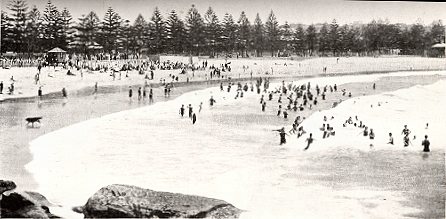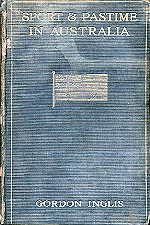 |
surfresearch.com.au
inglis : sport & pastimes in australia 1912 |
| home | catalogue | history | references | appendix |
|
The surf bather is divided into three
classes : the timidly venturous who go out breast high, the more expert
who dive under the first "roller," and the practised surfer who moves slowly
seaward to return at express speed on the crest of a great wave.
For sheer exhilaration as a past- time
it would be hard to surpass.
But-be sure of yourself before exhibiting
your prowess.
He is a foolhardy person who gives
all the trouble on our beaches and makes it necessary for brave men to
risk their lives to rescue him from difficulties of his own creation.
Provided a reasonable degree of precaution
be observed there is no chance of mishap.
No recreation has taken such a hold
upon the community, nor could progress have been more rapid. At the beginning
of the twentieth century surf bathing in Australia was practically unknown.
Even in 1903 the number of devotees
was very small, and there were many annoying restrictions governing the
pastime.
It proved a difficult matter to convince
some municipal potentates that the ardent supporters of surfing were not
animated by unworthy intent, but, happily, good sense prevailed.
With a freer understanding the delights
of the surf were acclaimed, fresh converts were made, and each morning
and evening in summer there are now thousands on the beaches.
Moreover, it has become recognized
that the value of land in the vicinity of the most attractive bathing spots
has ben enormously increased.
Allotments, that a dozen years
ago would not have aroused a vestige of interest, have changed hands at
a high figure.
The attitude of the Iocal authority
is refreshingly altered, and the leading beaches are now properly equipped
with dressing-room accommodation, etc.
Thus has one of the healthiest pastimes
come to its own.
LIFE-SAVING CLUBS
"The formation of Surf Bathers' Life
Saving Clubs in New South Wales," says Mr. Henry, "was indeed a sublime
idea, and, perhaps, a perfect ideal for everyone interested in swimming
and life-saving to follow.
The idea is that which in all times
has united people in the cause of humanity; it draws forth the highest
perfection by encouraging unselfish and noble acts.
I heard of these clubs years ago, and
thought them similar to the usual swimming club, with a change of title
to indicate that the members are surf bathers; but I find that I was wrong,
as their chief object is to save life and guard the surf bathers against
possible accidents, accidents which undoubtedly would be only too frequent
were it not for the vigilance of ? members.
It is the proud boast of many of these
clubs that not a single life has been lost on their particular beach since
their formation.
These clubs are generally known the
name of the beach on which they work, such as Manly, Bondi, Coogee, Cronulla,
North Steyne, Newcastle. etc.
Most of them have charming club-houses
built above the high-water level, in which the appliances for saving of
life are kept.
Most of the best swimmers in the district,
such Healy, Hardwick, Solomon, Baker, as well as others, belong to them,
and these swimmers are formed into squads, who take it in turn to stand
on guard on the beach watching the bathers in the surf.
By their side stands the life-saving
reel.
This reel consists of a revolving drum,
on which between 200 to 300 yards of rope is wound, to one of which a life-belt
is attached. The reel is a portable and can be moved up and down the beach
where required.
Immediately a bather is observed in
trouble, either by being dumped by a wave or carried out in a gulley, and
in danger of losing his life, an alarm is given; same moment the swimmer
standing on the beach rushes into the water and swims to the drowning person.
In the meantime another swimmer attaches
the life-belt to himself and goes after him, whilst others assist by easing
and guiding the rope behind him.
The first one to go out naturally arrives
to the drowning person first, and takes and supports him according to the
methods of the Life Saving Society.
Soon afterwards the second man arrives
and takes hold of the drowning person and relieves the first swimmer, who
takes hold of the rope, and all three on a given signal are drawn to shore
by those on land.
Sometimes they are brought in in a
very exhausted condition, and if the drowning person is landed apparently
dead, he is at once resuscitated and cared for until able to leave.
" I witnessed two of these rescues in
one day, and one of the rescued was in the club-room for several hours
before regaining consciousness, and I was told that on one day at Manly
as many as thirty-six people were taken out of the water, and although
many thousands bathed, not a life was lost.
This is the kind of work these clubs
are doing; when generally known it will receive the highest commendation
from everyone, especially as it is done without hope of reward, and often
at great personal risk.
I tried to find out with whom the idea
originated, and it seems to me I shall not be far out if I give the credit
to Mr. Walter H. Biddell, who by many is considered the father of surfing
inSydney.
He is also the inventor of a lifebuoy
in the form of a cigar, and formed the first life saving club or brigade
at Bronte Beach.
Mr. Biddell is a staunch supporter
of the Royal Life Saving Society, and has been connected with the New South
Wales Head Centre for many years.
The life-saving reel, I believe, was
devised by Warrant Officer Bond, who is still busily engaged in connection
with swimming at Bondi."



| home | catalogue | history | references | appendix |